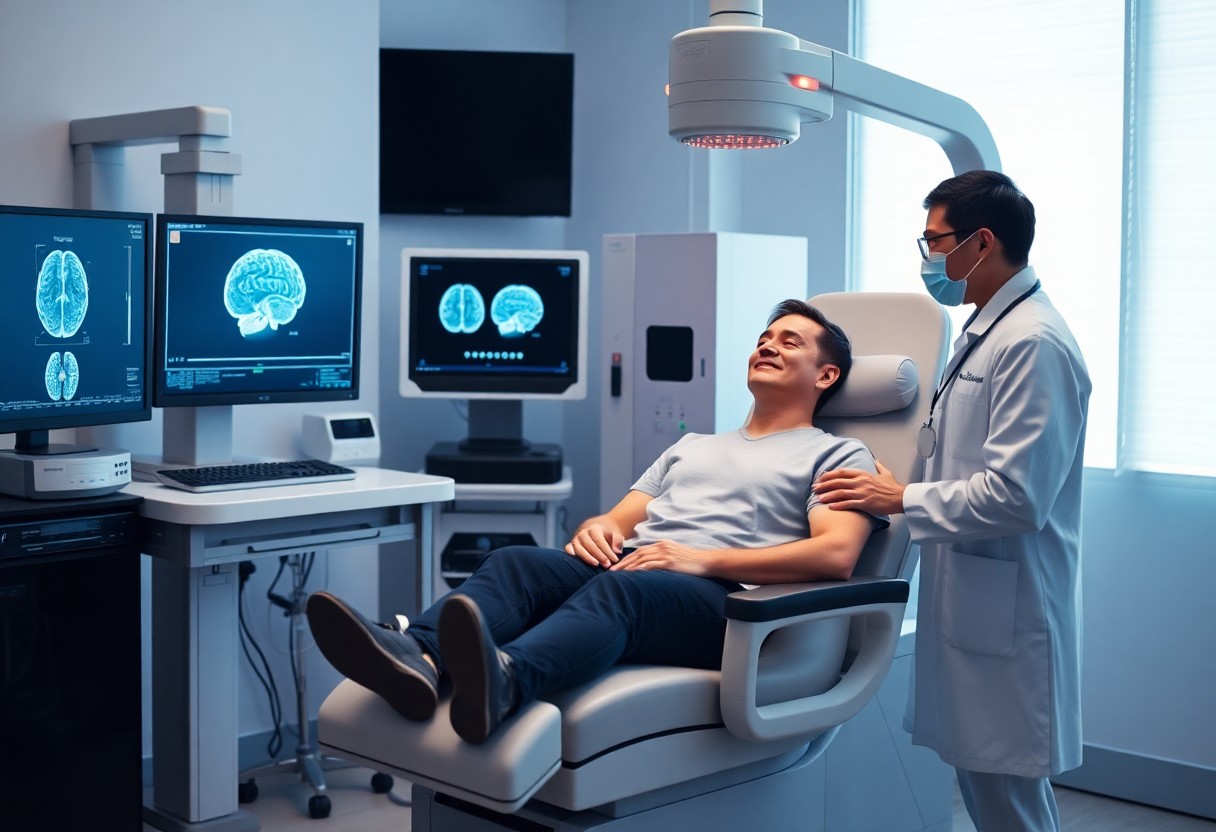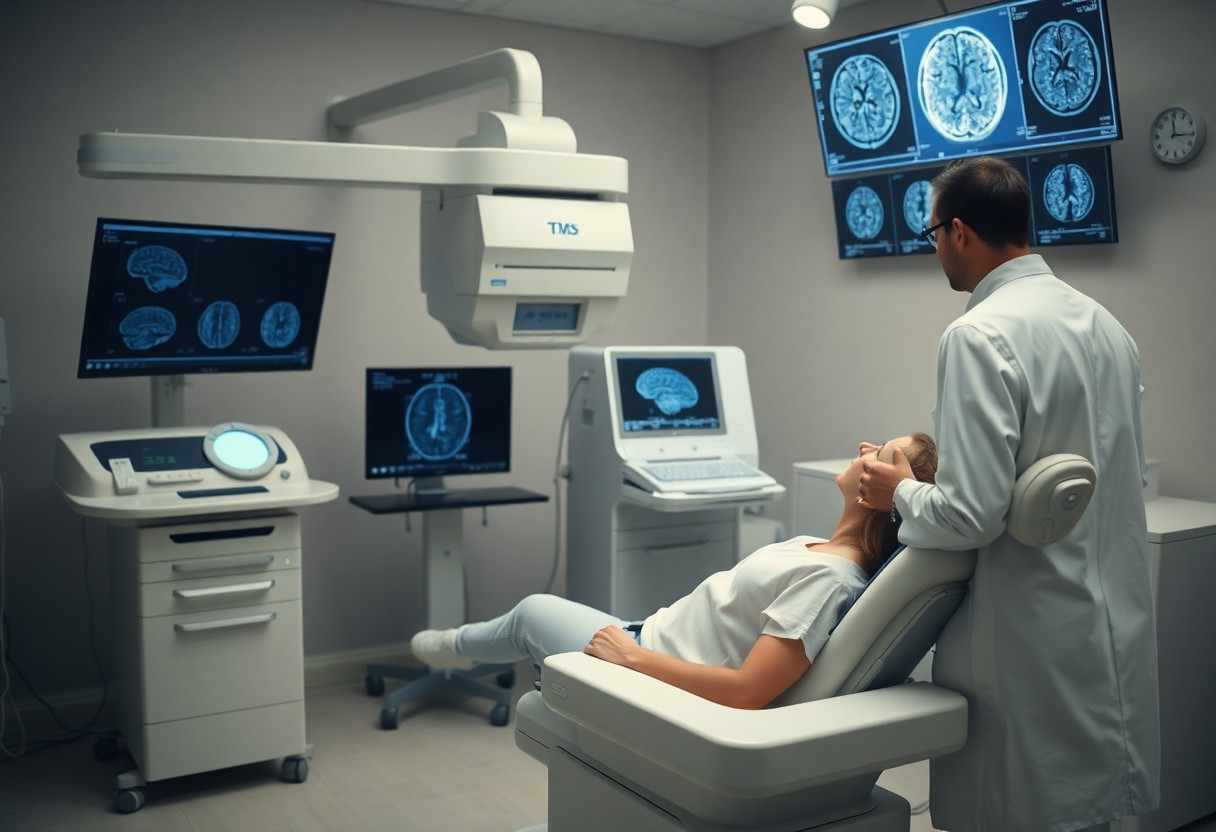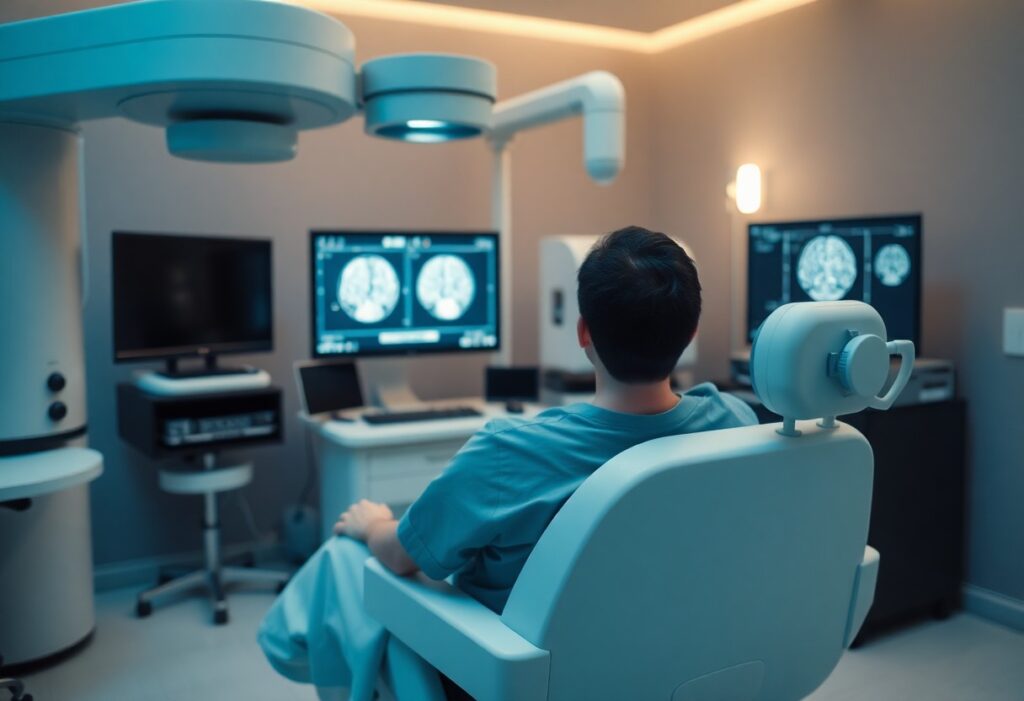You may find yourself grappling with the lasting effects of a traumatic brain injury (TBI), and it’s natural to seek innovative treatments that could enhance your recovery. Transcranial Magnetic Stimulation (TMS) offers a promising approach, utilizing magnetic fields to stimulate nerve cells in the brain. This non-invasive therapy has shown potential in alleviating symptoms associated with TBI, from cognitive impairments to mood disorders. In this blog post, we will explore into how TMS works, its benefits, and what you can expect as you explore this groundbreaking option for healing.
Key Takeaways:
- TMS therapy offers a non-invasive treatment option for individuals with Traumatic Brain Injury (TBI), aiming to enhance recovery and improve cognitive function.
- Neuroplasticity is a key mechanism of TMS, promoting the brain’s ability to reorganize and adapt following TBI, leading to potential improvements in symptoms.
- Research is ongoing, but early results suggest that TMS may significantly contribute to the rehabilitation process, providing new avenues for healing in TBI patients.

Understanding Traumatic Brain Injury (TBI)
To comprehend the intricacies of Traumatic Brain Injury (TBI), it’s imperative to research into its definition, causes, symptoms, and the long-term effects it can have on your life. As research progresses, innovative treatments such as Transcranial Magnetic Stimulation (TMS) have emerged, offering potential avenues for recovery. For more insights, you may want to explore How TMS Can Help Traumatic Brain Injury Survivors Recover.
Definition and Types of TBI
Across the medical literature, TBI is defined as any disruption in normal brain function due to an external force. Various types include:
| Concussion | Closed Head Injury |
| Contusion | Pensetrating Injury |
| Diffuse Axonal Injury | Severe TBI |
| Moderate TBI | Closed TBI |
| Mild TBI | Any form of TBI. |
Causes and Risk Factors
Around various socioeconomic factors, TBI can arise from different causes, and certain risk factors may increase your likelihood of experiencing it. Common causes include:
- Falls
- Motor Vehicle Accidents
- Sports injuries
- Assaults
- This information highlights the significant risk associated with TBI occurrences.
Causes of TBI can also relate to your lifestyle choices. Environmental exposures, reckless behaviors, and participation in high-impact sports drastically increase your risk. Furthermore, age and preexisting conditions might contribute to the severity of an injury. Here are some critical considerations:
- The elderly are particularly vulnerable due to balance and mobility issues.
- Children might also be at higher risk due to active play.
- Participation in certain professions or activities can elevate your exposure to injury.
- This underlines the need to recognize varying risks associated with different populations.
Symptoms and Diagnosis
Traumatic brain injuries often present with a range of symptoms that can manifest immediately or develop over time. These may include:
- Headaches
- Confusion
- Nausea
- Memory problems
- Changes in mood or behavior.
The signs and symptoms of TBI can vary greatly among individuals, making diagnosis challenging. Evaluating your symptoms may involve imaging tests like CT scans or MRIs. The focus remains on understanding how your brain has been impacted and determining appropriate treatment strategies.
Long-term Effects of TBI
With proper understanding, it is vital to acknowledge the long-term effects TBI may have on your life. Potential complications include:
- Cognitive impairments
- Emotional disturbances
- Physical disabilities
- Increased risk for neurodegenerative diseases
- Any prolonged challenges could impact your quality of life.
Plus, tackling the long-term effects could require multidisciplinary approaches, such as rehabilitation services, mental health support, and ongoing medical care. Recognizing these potential outcomes allows for better preparation and management strategies as you navigate your recovery journey.
Traditional Therapies and Interventions
Any discussion about the treatment of Traumatic Brain Injury (TBI) must first address the traditional therapies and interventions available. These methods form the foundation of your recovery journey and set the stage for exploring innovative options like TMS. If you are interested in understanding the traditional approaches further, Traumatic Brain Injury Treatment is Responsive to MeRT … highlights various techniques that can aid in healing.
Medical and Surgical Treatments
About medical treatments, a range of medications can manage symptoms such as pain, depression, and anxiety following a TBI. In more severe cases, surgical interventions may be necessary to alleviate pressure on the brain or repair structural damage, promoting better recovery outcomes.
Rehabilitation Approaches
Traditional rehabilitation approaches are pivotal in your recovery process following a TBI. These interventions include physical, occupational, and speech therapy, designed to help you regain lost skills and adapt to changes in function.
Approaches like neuropsychological testing and cognitive rehabilitation training can help you rebuild cognitive functions and improve emotional regulation. Personalized therapy plans will address your unique challenges, fostering a supportive environment conducive to healing.
Limitations of Current Treatments
Any approach to TBI recovery has its limitations. While current therapies can aid in symptom management and skill recovery, they may not address the underlying issues or brain functions affected by the injury.
It is imperative to understand that many individuals experience persistent symptoms even after undergoing standard treatments. This reality paves the way for exploring newer therapies, such as TMS, which might provide additional relief and promote healing where traditional methods fall short.
Overview of Transcranial Magnetic Stimulation (TMS)
Unlike traditional treatments for Traumatic Brain Injury (TBI), Transcranial Magnetic Stimulation (TMS) offers a non-invasive alternative that can promote healing in your brain. This innovative approach utilizes magnetic fields to stimulate nerve cells in the brain, making it a promising option for individuals looking to recover from the cognitive impairments often associated with TBI.
What is TMS?
What you need to know about TMS is that it is a non-invasive therapy that employs magnetic fields to enhance neural activity. By targeting specific areas of your brain, TMS can help modulate and improve cognitive functions that may have been affected by TBI.
Mechanism of Action
To understand how TMS works, it’s important to recognize that it induces electrical currents in the brain through electromagnetic induction. When focused on certain brain regions, this stimulation can facilitate neuronal activity, promoting neuroplasticity and potentially aiding in recovery from injuries.
Hence, TMS is thought to work by enhancing synaptic efficiency and promoting brain plasticity, which is vital for learning and recovery after a TBI. When you undergo TMS, targeted areas of your brain can re-establish lost connections, enabling improved communication between neurons and potentially alleviating some of the cognitive deficits caused by your injury.
Historical Background and Development
Against the backdrop of psychiatric treatments, TMS has evolved since its inception in the late 1980s. Initially used for research purposes, it has gained recognition for its therapeutic potential, paving the way for its application in various neurological disorders.
Considering the advancements in technology, TMS has undergone significant development over the years, transitioning from a research tool to a therapeutic modality. You now have access to clinical applications that help address various conditions, including TBI, as ongoing studies continue to explore its effectiveness in improving outcomes for individuals like you seeking recovery and healing.
The Role of TMS in Treating TBI
For individuals grappling with the aftermath of Traumatic Brain Injury (TBI), Transcranial Magnetic Stimulation (TMS) presents a groundbreaking approach to recovery. This non-invasive neuromodulation technique aids in the rehabilitation of cognitive and emotional functions, offering hope to those who often feel limited by their injuries.
Research Studies and Findings
For those interested in the scientific basis of TMS, several studies have indicated its efficacy in improving cognitive functions and reducing depressive symptoms in TBI patients. Research demonstrates that regular TMS sessions can lead to significant improvements in overall quality of life, supporting its role as a valuable therapeutic intervention.
Benefits of TMS for TBI Patients
For TBI patients, TMS offers multiple benefits that can enhance your recovery journey. This technology is non-invasive, painless, and can be tailored to address specific neurological deficits, making it a flexible treatment option.
A primary benefit of TMS is its ability to stimulate brain regions linked to mood and cognitive function. By targeting these areas, TMS can alleviate symptoms such as anxiety, depression, and cognitive fog that often accompany TBI, fostering a sense of wellbeing and improved mental clarity. Many individuals report enhanced focus, motivation, and emotional stability following treatment.
Comparative Analysis with Other Treatments
Around the world, various treatment options exist for TBI, yet the effectiveness of these methods can vary widely. Below is a comparison of TMS to conventional therapies.
Treatment Options Comparison
| Treatment Method | Efficacy |
|---|---|
| TMS | High effectiveness in cognitive and emotional recovery |
| Medication | Variable effectiveness with potential side effects |
| Physical Therapy | Helpful for physical symptoms, but less so for cognitive aspects |
Hence, exploring TMS as a treatment modality can greatly benefit your recovery process. Conventional options, while beneficial, may not adequately address the cognitive and emotional challenges that follow TBI. By choosing TMS, you might find a more comprehensive solution that targets the root of your issues, promoting holistic healing and a better quality of life.
Clinical Applications of TMS for TBI
Many researchers and clinicians are exploring the benefits of Transcranial Magnetic Stimulation (TMS) in treating Traumatic Brain Injury (TBI). TMS has shown potential in addressing the diverse symptoms associated with TBI, including cognitive impairment, mood disorders, and motor function challenges. Its ability to enhance neuroplasticity opens new avenues for recovery, making it an exciting area of study in neurorehabilitation.
TMS in Acute vs. Chronic TBI
Around the timeline of TBI, TMS can be beneficial not just in chronic cases but also in acute situations. Early intervention with TMS may enhance recovery by promoting neural connectivity and reducing symptoms more effectively. In chronic conditions, TMS serves as a complementary therapy, targeting residual cognitive and emotional difficulties that persist long after the injury.
Customizing TMS Protocols for Individual Patients
After assessing your specific needs and symptoms, TMS protocols can be tailored to optimize treatment outcomes. Customizing the stimulation frequency, intensity, and duration makes it possible to align the therapy more closely with your unique situation and recovery goals.
Even subtle differences in your TBI symptoms can influence how TMS is applied. By working closely with your healthcare provider, you ensure that the parameters of the TMS treatment are adjusted according to your individual response to therapy. This personalized approach increases the likelihood of fostering significant improvements in brain function and overall quality of life.
Multidisciplinary Approaches Integrating TMS
Clinical practice often benefits from a multidisciplinary approach when incorporating TMS into TBI treatment plans. This collaborative model allows various specialists, including neurologists, psychologists, and occupational therapists, to work together to provide a more comprehensive understanding of your needs and the best strategies for treatment.
Protocols designed within a multidisciplinary framework can greatly enhance the efficacy of TMS. Through integrated strategies from different disciplines, providers can collectively identify the most appropriate treatment modalities, monitor your progress, and make necessary adjustments to maximize recovery. This holistic approach aims to address not only the neurological aspects of TBI but also the psychological and functional dimensions, leading to a more complete rehabilitation experience.

Challenges and Future Directions
Now, as TMS emerges as a promising intervention for traumatic brain injury (TBI), it is crucial to consider the challenges that lie ahead in research and application.
Limitations of Current Research
For those exploring TMS for TBI, it is important to recognize that current research is still in its early stages. Many studies have small sample sizes, varied methodologies, and inconsistent results, which may hinder the ability to generalize findings across different populations and injury severities.
Potential Risks and Side Effects
Along with its therapeutic potential, TMS may also pose certain risks and side effects. Although serious adverse effects are rare, you might experience mild discomfort or headaches during or after treatment.
Also, you should be aware that some patients may report transient mood fluctuations or increased anxiety following TMS sessions. While these effects are generally mild, it’s crucial for you to discuss any concerns with your healthcare provider prior to starting treatment, ensuring that it is safe and suitable for your condition.
Future Trends in TMS Technology
Side effects aside, advancements in TMS technology are promising. Researchers are exploring more targeted stimulation techniques, such as using neuronavigation systems and personalized treatment protocols, to enhance the effectiveness of TMS in treating TBI.
Current trends indicate a move towards integrated approaches that combine TMS with other therapeutic modalities like physical therapy and cognitive rehabilitation. This holistic strategy could provide you with improved outcomes, making your recovery process more efficient and effective. As the field grows, it’s crucial to stay informed about these developments to maximize the potential benefits of TMS for TBI.
To wrap up
Drawing together the promising advancements in Transcranial Magnetic Stimulation (TMS) for Traumatic Brain Injury (TBI), you can find renewed hope in the possibilities for healing and recovery. By engaging with this innovative therapy, you may enhance your cognitive function and emotional well-being, paving the way for a better quality of life post-injury. As research continues to expand, TMS stands out as an evidence-based option for those affected by TBI, offering you a chance to reclaim your life and overcome the challenges associated with brain injuries.
FAQ: TMS for Traumatic Brain Injury (TBI) – A New Hope for Healing
Q: What is Transcranial Magnetic Stimulation (TMS) and how does it work for TBI?
A: Transcranial Magnetic Stimulation (TMS) is a non-invasive neuromodulation technique that utilizes magnetic fields to stimulate nerve cells in the brain. For patients with Traumatic Brain Injury (TBI), TMS can help restore neural function by enhancing neuroplasticity—the brain’s ability to reorganize itself and form new connections. During a TMS session, magnetic pulses are delivered to specific areas of the brain associated with cognitive and emotional functions, potentially improving symptoms like depression, anxiety, and cognitive impairments commonly experienced after a TBI.
Q: What are the potential benefits of TMS for individuals with TBI?
A: TMS offers several potential benefits for those recovering from TBI. It may reduce symptoms of depression and anxiety, improve cognitive functions such as memory and attention, and enhance overall quality of life. Additionally, TMS can be tailored to target specific issues related to TBI, making it a personalized therapeutic option. Some patients report greater engagement in daily activities and an improved sense of well-being following TMS treatment.
Q: How many sessions of TMS are typically needed to see results for TBI?
A: The number of TMS sessions required for individuals with TBI can vary based on the severity of the injury and the specific symptoms being treated. Typically, a standard treatment protocol involves 20 to 30 sessions over a few weeks, with each session lasting about 30 to 40 minutes. Some patients may begin to notice improvements after just a few sessions, whereas others might require the full course for significant results. Following the initial treatment, maintenance sessions may be recommended to sustain the benefits.
Q: Are there any side effects associated with TMS treatment for TBI?
A: TMS is generally well tolerated and has fewer side effects compared to many pharmacological treatments. Common side effects can include mild headache, discomfort at the site of stimulation, or transient lightheadedness. Serious side effects are rare but can include seizures, particularly in individuals who have a history of seizures or certain neurological conditions. It is imperative for patients to discuss their medical history with their healthcare provider to ensure TMS is a safe option for them.
Q: Who is a suitable candidate for TMS therapy for TBI?
A: Suitable candidates for TMS therapy for TBI are individuals who have experienced a traumatic brain injury and are experiencing persistent symptoms such as depression, anxiety, or cognitive difficulties. It is particularly beneficial for those who have not found relief from traditional therapies like medication or psychotherapy. However, candidates should be assessed by a qualified healthcare professional to determine if TMS is appropriate for their specific condition and medical history.







